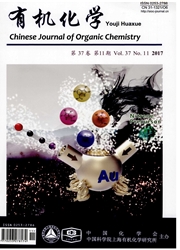

 中文摘要:
中文摘要:
简单的锇起始物OsHCl(PPh3)3(1)或OsCl2(PPh3)3(2)与3-氯-3-甲基-1-丁炔反应可分别得到锇的烯基卡拜配合物OsHCl_2(≡CCH=CMe_2)(PPh3)2(3)和OsCl3(≡CCH=CMe_2)(PPh3)2(4).化合物3与二苯基(苯乙炔基)膦反应可转化为三个二苯基(苯乙炔基)膦配位的锇烯基卡宾配合物OsCl2(=CHCH=CMe2)(Ph2PC≡CPh)3(5),而化合物4与二苯基(苯乙炔基)膦反应得到膦配体取代产物OsCl3(≡CCH=CMe2)(Ph2PC≡CPh)2(6).二苯基(苯乙炔基)膦配体较弱的供电子能力及较小的空间位阻是促成化合物3发生锇上的原子氢配体到卡拜碳的1,2-迁移而转化为卡宾配合物5的原因.
 英文摘要:
英文摘要:
Reactions of the simple osmium precursors OsHCl(PPh3)3(1) or OsCl2(PPh3)3(2) with 3-chloro-3-methylbut-1-yne afforded OsHCl2(≡CCH=CMe2)(PPh3)2(3) or OsCl3(≡CCH=CMe2)(PPh3)2(4),respectively.Treatment of 3 with Ph_2PC≡CPh led to the formation of the tris-diphenyl(phenylethynyl)phosphine alkenylcarbene complex OsCl_2(=CHCH=CMe2)(Ph2PC≡CPh)3(5),while complex 4 underwent simple phosphine ligand substitution with Ph2PC≡CPh to give OsCl3(≡CCH=CMe_2)(Ph2PC≡CPh)2(6).Presumably,upon the phosphine ligand substitution of PPh3 in 3 by Ph2PC≡CPh,the relatively electron-poor nature of the later decreased the electron density of the osmium center,and thus promoted the transformation of the hydride-carbyne to carbene via the 1,2-shift of the hydride ligand from Os to the carbyne carbon,which was then further facilitated by the coordination of a third less bulky Ph2PC≡CPh ligand to the osmium center to give the stable 18 e product 5.
 同期刊论文项目
同期刊论文项目
 同项目期刊论文
同项目期刊论文
 A half-sandwich 1,2-azaborolyl ruthenium complex: Synthesis, characterization, and evaluation of its
A half-sandwich 1,2-azaborolyl ruthenium complex: Synthesis, characterization, and evaluation of its 期刊信息
期刊信息
